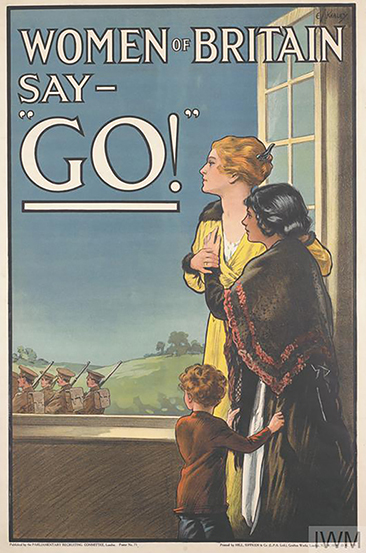2.1 British propaganda – Example 1
In this section examples have been provided that students can use to develop their skills in document analysis using the suggested questions given earlier. Model answers have been provided for your reference.
Activity 3 Primary source analysis
Let’s use the same questions we applied to primary source documents in the following analysis of the propaganda poster: Women of Britain say “Go!” (1915).
Some contextual information about this poster can be found on the Imperial War Museum website [Tip: hold Ctrl and click a link to open it in a new tab. (Hide tip)] .
You have the option to consider each question yourself before revealing our specimen answers or use our worked example for students’ skills development.
Who?
Answer
This is a British propaganda poster, produced by the Parliamentary Recruiting Committee (the text to the bottom left of the image confirms this).
When?
Answer
The date of the poster’s production is not clear from this image, but students may be able to work out an approximate date based on their additional contextual knowledge of the First World War. Because this is a recruiting poster, we know that it must pre-date the introduction of conscription in January 1916. The information on the Imperial War Museum’s website confirms that the poster was created in 1915.
What?
Answer
The poster depicts two women and a young child standing at an open window and looking out at armed troops marching to war.
Purpose
Answer
This is a recruiting poster designed to encourage men to enlist in the army. It also encourages women to pressurise men into enlisting. At the outbreak of the war, Britain had a relatively small standing army and no system of conscription. Before introducing conscription, the government relied on men to volunteer their services, using posters such as this to promote recruitment.
How?
Answer
The poster’s design is clearly intended to persuade and capture attention. The word ‘Go’, for example, is capitalised, underlined and presented in a larger typeface, reinforcing the poster’s central message.
Uses for historians
Answer
This poster has a number of uses as a primary source for historians. First, it provides evidence of how the Parliamentary Recruiting Committee sought to encourage men to enlist in the army during the First World War. More broadly, it also provides evidence of attitudes to masculinity and femininity during the First World War.
Like all sources, however, the poster has its limitations. For instance, it does not tell us how men and women viewed enlistment in reality. And, as with all examples of propaganda, it is difficult to gauge how people responded to posters like this. Whether they were successful or not is open to debate.

